Date of Exploration : 5 Feb 2012
What do the KL Tower, Petronas Twin Towers and the 95m flag pole at Merdeka Square have in common? They all make you crank your head up towards the sky to fully appreciate them.
But this trip to Kuala Lumpur, I realised they aren't the only attractions that will have you looking heaven-ward. There's the KL Bird Park that will train one's upward neck arch in no time. And the best thing is, it's right smack within the city, a mere 10 minutes cab ride from the Twin Towers (in the absence of clogged traffic).
Laying claim to be the world's largest free-flight walk-in aviary, I've wanted to visit for quite some time but something always thwarted my plans. I almost didn't make it this time too if not for the persistence of my travel companion.
 |
| Top Left : Entrance to KL Bird Park. Top Right : A pageant of Black-tipped Doves. Bottom Left : Paved routes around the park. Bottom Right : Pathway leading to Waterfall Aviary. |
So is the KL Bird Park worth checking out? Personally, I enjoyed it. The park wasn't as huge as I thought it to be but it is well-kept with plenty of opportunities to have personal encounters with the residents. The
KL Bird Park website does a great job in explaining and orientating the avi-exhibits so I shan't go into details on how to navigate the place.
Basically, the park is divided into
4 zones housing such designated areas as Love Aviary, Free-Flight Aviary, Brahminy Land (kite eagle), Flamingo Pond, Bul Bul Land, Hornbill Park, World of Parrots, Oriental Bird Aviaries, Waterfall Aviary, etc.
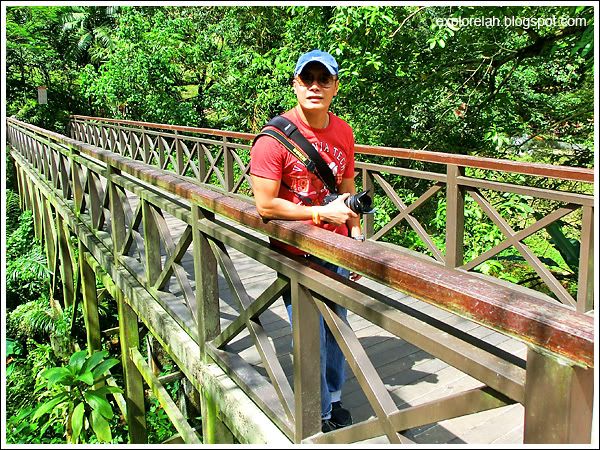 |
| At the Bird Park, city greens get adorned with nature's living jewels in a colourful embroidery of peacocks, parrots, birds of prey and affectionate hornbills. But where are the birds in this photo?! They are coming up in the following photos... |
In this post, I'll share with you what I came across, what to expect, and some interesting bird facts I'd just come to learn. This post is organised according to some of the bird species rather than by where they reside within the park's designated zone since quite a few of the bird species are free to fly around.
The Parrots
Upon entering the park, visitors are greeted by free-flying parakeets within a netted corridor. The avian offering here is chiefly the Indian Ringneck Parakeet (a.k.a. Asian Ringneck) in 3 colour variations - yellow, green and cobalt.
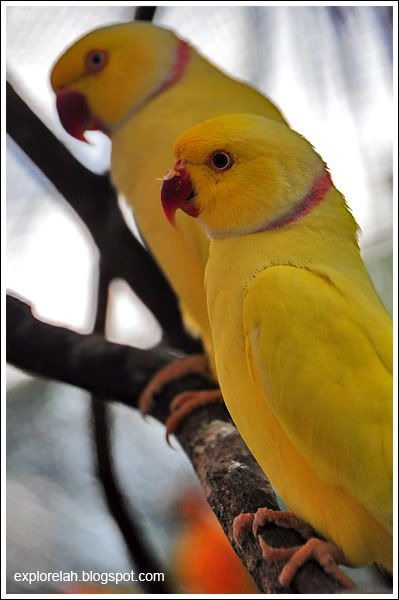 |
| Yellow Indian Ringnecks. |
Being a newly inducted fan of avian photography, I did my research before coming here. But I got confused by KLBP's website. I read that I'll be able to see Indian Ringnecks in the Love Aviary so I thought the Ringnecks are also known as Lovebirds. Wrong! A search online later showed that
Lovebirds have shorter tails and are smaller.
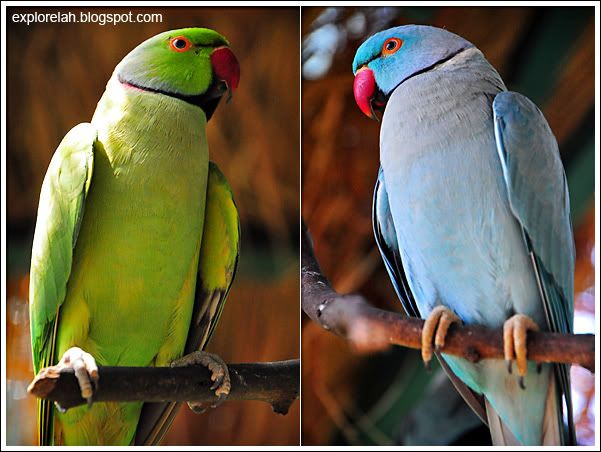 |
| Green and cobalt Ringneck. These birds like it spicy! I saw them being fed chilli. |
What's the big deal about getting Ringnecks mixed up with Lovebirds you may ask. Well, Ringnecks are polygamous while Lovebirds are strictly monogamous. Once two Lovebirds form a pair, they bond for life and they will sit by each other's side for long hours. Ringnecks just have orgies during breeding season.
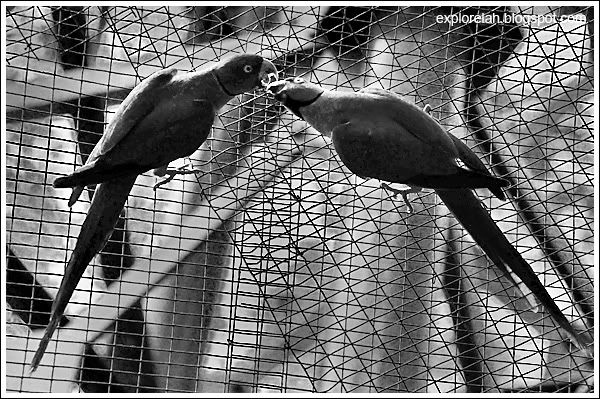 |
| A pair of Ringnecks enjoying some tender moments. They seem to be constantly kissing each other. So sweet! |
My friend pointed out that it's such a waste of time sitting there doing nothing. But my take is that being able to be by the side of someone we love, that's doing something precious. The heart is always blissfully busy when there's love.
And if one of the Lovebirds died before the other, the surviving spouse may never take another mate again and will resolve to just take care of the young by other pairs. Lovebirds make great pets as they bond closely with their masters but you must only get one and not a pair or they will indulge in each other. And be prepared to spend a lot of time with it. If you're too busy, it's better for the Lovebird to have a partner.
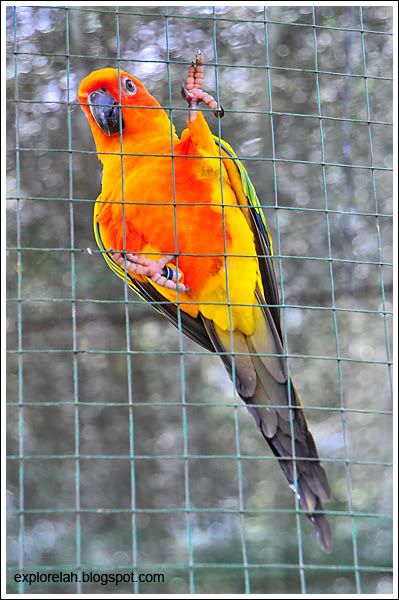 |
| Lonesome Loverbird. This Sun Conure is the Lovebird species found in KLBP's Love Aviary. It is estimated that only 10 - 15% of birds mate for life (Lovebirds, hornbills, eagles, penguins, swans, some owls, etc). Other's are polygamous (eg. chickens) or may be monogamous for an entire mating season (eg. pigeons and most birds) or several seasons (eg. Tree Swallows, Mourning Doves). Valentine's Day is coming up. Is your relationship that of an eagle or chicken? :o) |
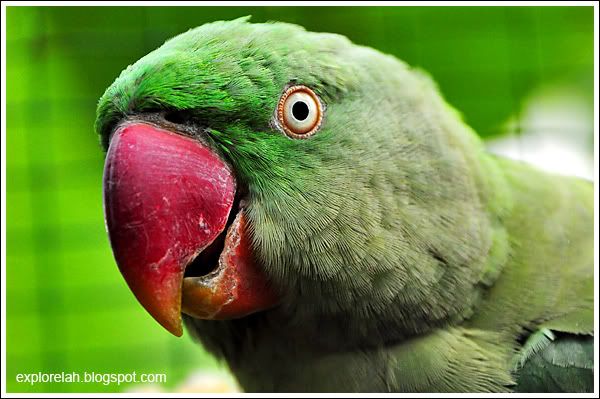 |
| Perhaps the chilli these fellas are being fed that makes this parakeet rather hot tempered. It kept biting me when I tried to stroke it. Pretty strong jaws it has! |
The Parrot genus has quite a branched taxonomy with 350 species but the common ones seem to be the Macaw, Cockatoo, Conure, Parakeet, and Lorikeet (or Lory). Small to medium-sized parrots are generally termed as Parakeets (which can include Conures and Lories). I know, it's confusing right?
Other than their mild difference in appearance, one way to tell a Parakeet from a Lory is by the bird's tongue. The tongue tip of a Parakeet is sharp while a Lory has blunt, brusk-like tongue for feeding on nectar.
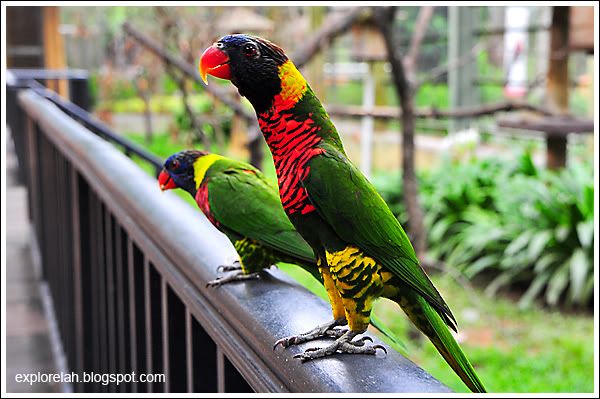 |
| Rainbow Lories at the World of Parrots looking expectantly to be fed. |
Other than the Love Aviary, the other place to get Parroty is at the World of Parrots enclosure. This section features free-flying Parakeets and Lories and a collection of rare and endangered Parrots.
You can purchase sunflower seeds to feed the free-flying birds for RM2.00. I'm so stoked to own Lories as pets after visiting! Feeding them is so therapeutic for me.
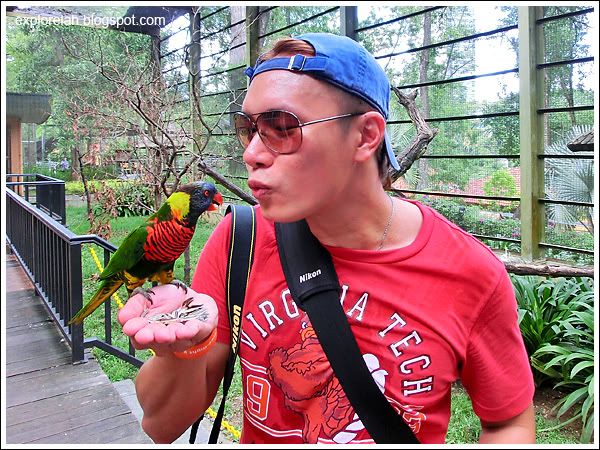 |
| While there were many Lories that came to eat, this one stayed with me the longest. At one point, a Lory flew onto my right shoulder and started chirping. After a while, it crossed to my left shoulder and continued talking into my ear. It's as if it's trying to tell me something. The connection we had was just awesome! I'm not sure but I think it's this Lory who made my experience so very special. |
 |
| The rare and endangered Vulturine Parrot looks rather scary. |
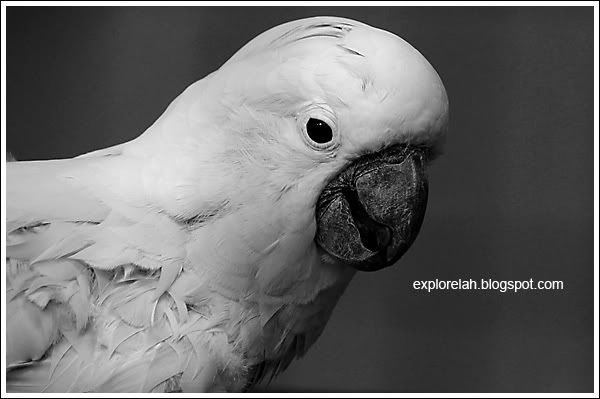 |
| The endangered Moluccan Cockatoo is considered to be the smartest of parrot species. My friend spent a long time repeating "Hello" to it. I wondered who's the real Parrot! Ha. But this fella did utter "Hello" back. Awesome! |
Leaving the cage of love, we were greeted by an assortment of Storks, Egrets Pigeons, Doves and peafowl in the Free-Flight Aviary.
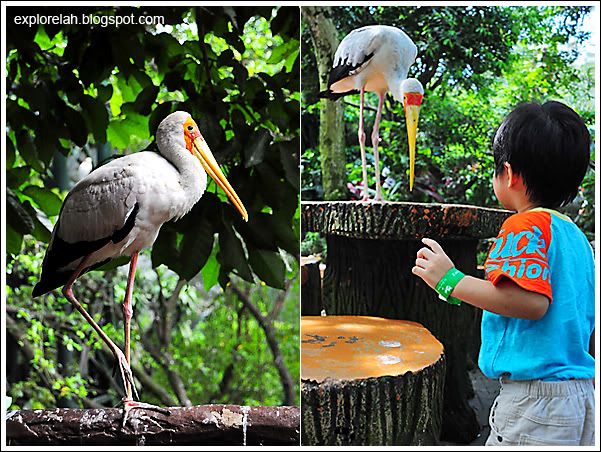 |
| Getting upclose with so many exotic birds was exciting for a city boy like me. Ok, I'm not a boy. The little guy in the photo is. |
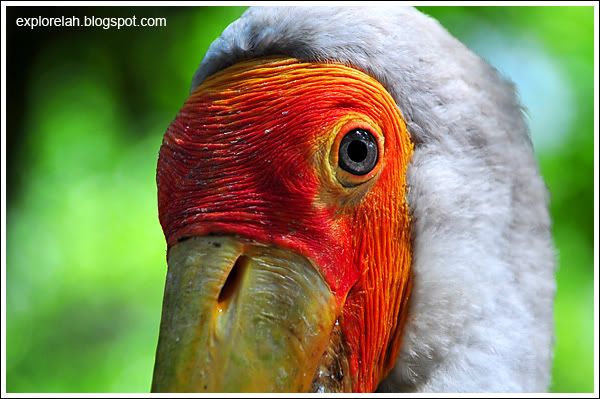 |
| Facial profile of a Yellow-Billed Stork. The big bird has such a wise, sagely aura about it. |
 |
| Storks in their preferred habitat at the Waterfall Aviary. In English and Scandinavian myths, Storks deliver newborn babies to their mothers. |
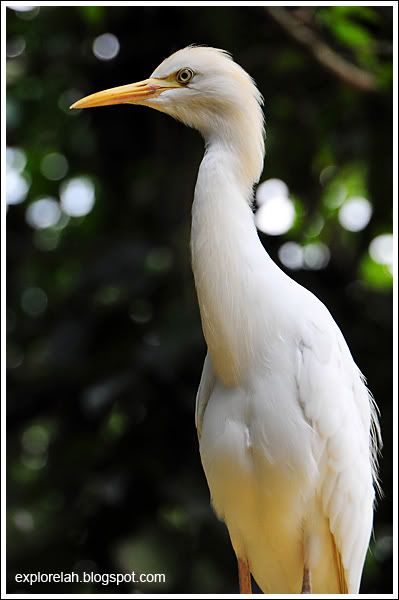 |
| The Egrets look so mischievious and up to no good. Reminds me of Bart Simpson! |
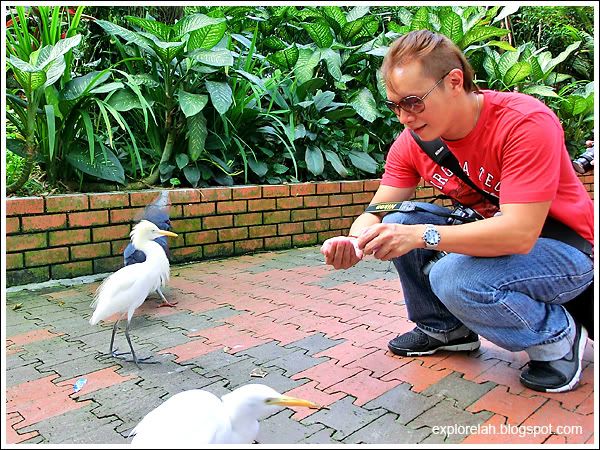 |
| Bird feed can be bought at dispensers around the park for RM1.00 (2 X RM0.50) so visit the park with ample 50 cents coins. I was worried the sharp beaks will hurt if I feed them by hand but that fear was unfounded. |
The Hornbills
I fell in love with Hornbills after visit to
Langkawi and have since wanted to see one upclose. I'm in luck because KLBP has a few species of Hornbill exhibits including the endangered and elusive Great Hornbill and Rhinoceros Hornbill.
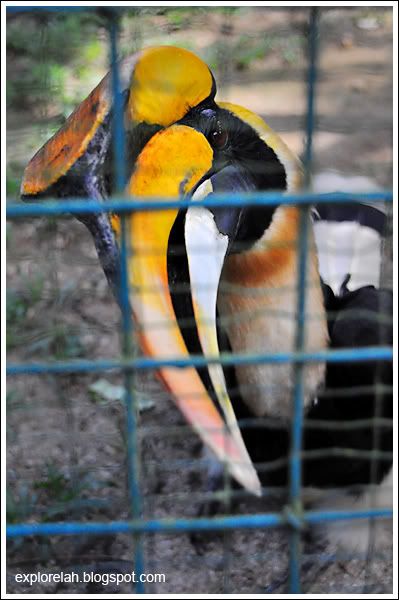 |
| This Great Hornbill loves coming up to the edge of its cage to meet visitors and it has this most adorable way of tilting its head when looking at you. Feels more puppy dog than bird! |
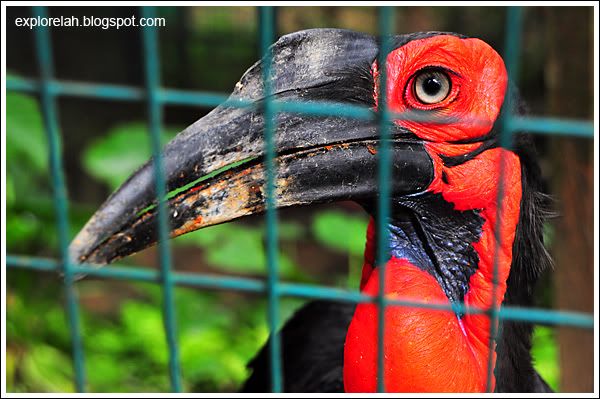 |
| Southern Ground Hornbill at the Horbill Park section of KLBP. Females have a blue patch at their throats. |
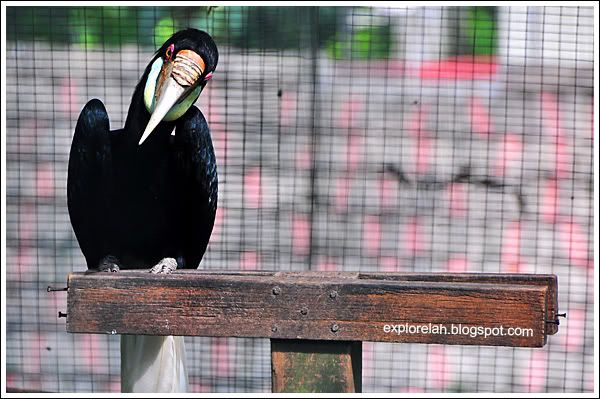 |
| Aww... This variation of the Asian Black Hornbill is just so cute! |
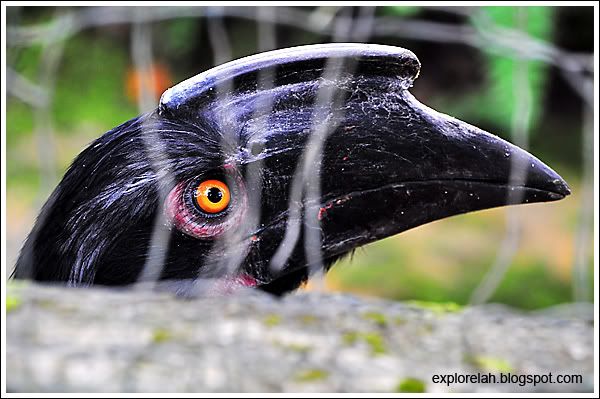 |
| Piercing gaze of the Black Hornbill. |
 |
| Although not as colouful as the other hornbills, this one is uber affectionate and will stick its beak out a drain hole for you to pet it. Maybe it's expecting food but even after numerous times of sticking its beak out without getting fed, it continues to do so whenever it sees my hand at the hole's opening. |
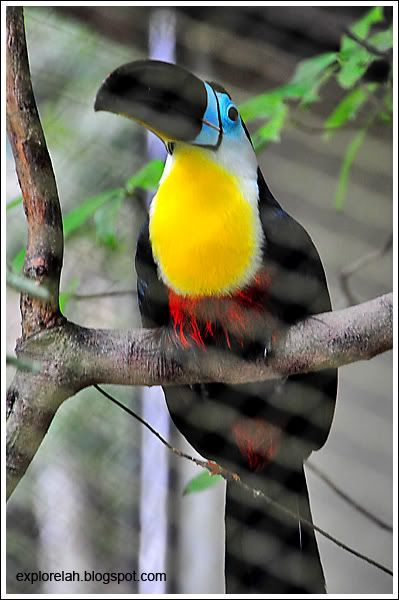 |
| Channel-Billed Toucan. Looks related to a Hornbill although they are not of the same taxonomic lineage. Breakfast cereals anyone? |
Get Bird-Brained!
KL Bird Park has over 3,000 birds from 200 indigenous and migratory species. That's a lot of birds for the camera!
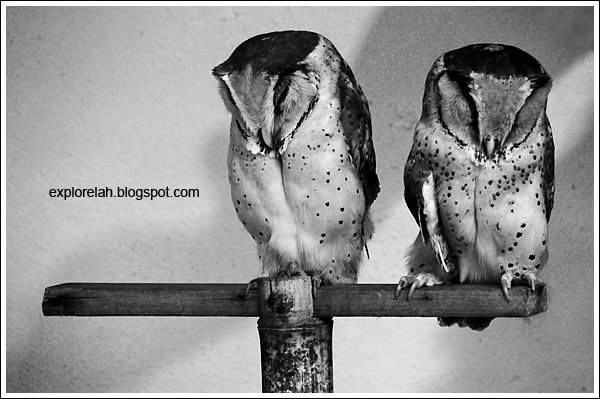 |
| Owls at KLBP's photo booth. My friend was musing why they do not fly away since the booth is without fencing. To keep birds from flying, their wings have to be clipped. Though clipping doesn't hurt the bird when done correctly, it causes them to lose balance and not fly very high or far. They can also be trained to fly only when requested. But psychologically, the birds may be affected as they can't do what's natural to them to escape from fearful situations or distress. |
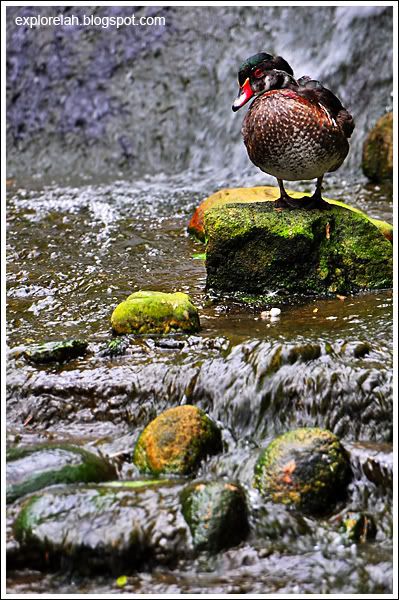 |
| Mandarin Duck contemplating a slide ride or stay dry. |
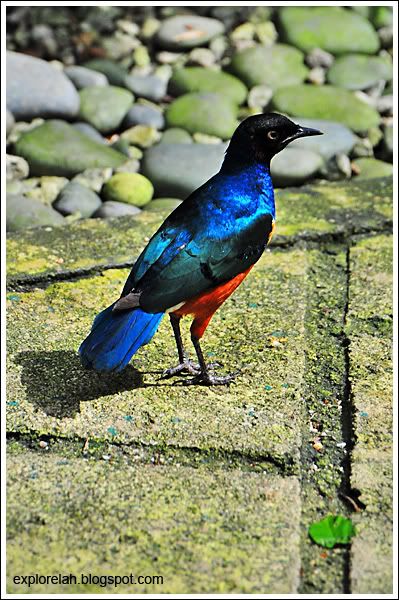 |
| Asian Fairy Bluebird. The bird has a very comical way of walking. |
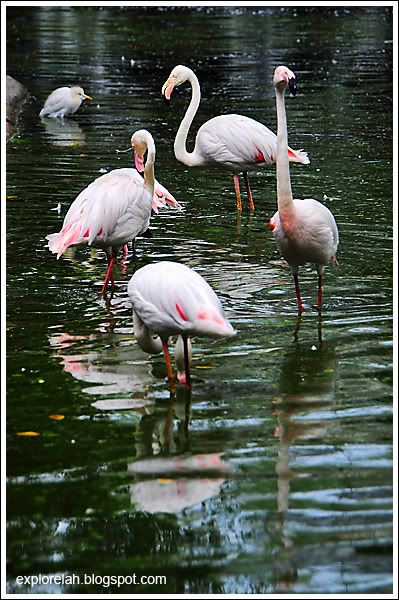 |
| Flamingos are white, pink or orange depending on what they eat. A diet rich in plankton and algae gives the birds richer colours than a shrimp-based diet. In captivity, flamingos are fed foods enhanced with beta-carotene to bring out their colours. |
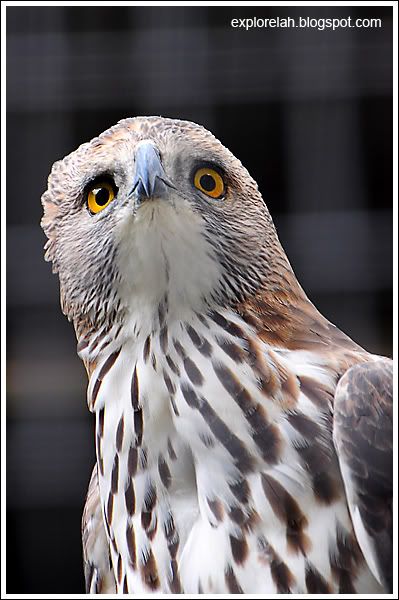 |
| Such a regal stance and penetrating eyes. Can't remember the name of this hawk. Or is it an eagle? |
The Peafowls
What I really liked about KL Bird Park is the abundance of peafowls. The place is literally crawling with them; their luminous turqouise-emerald sheen adding a sparkle everywhere you look. Both Peacocks and Peahens are well-kept with showy beautiful coats and the males sure love show-off.
I taught it's a matter of striking lottery to see a Peacock open its tail feathers but not these guys here. I saw not just one, but three peacocks fanning out their tail feathers at the same time! So breathtakingly stunning, it's surreal.
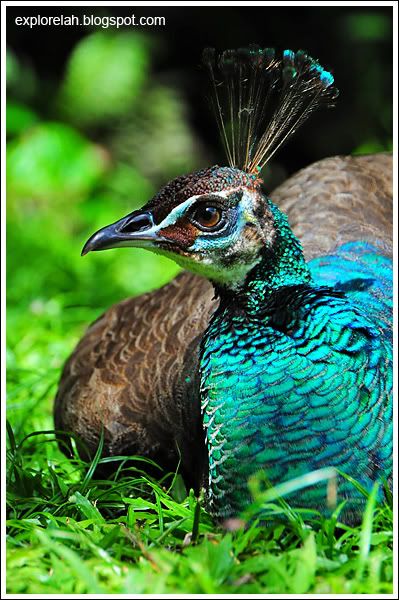 |
| A Peahen sunbathing in its brilliant neon blue suit. |
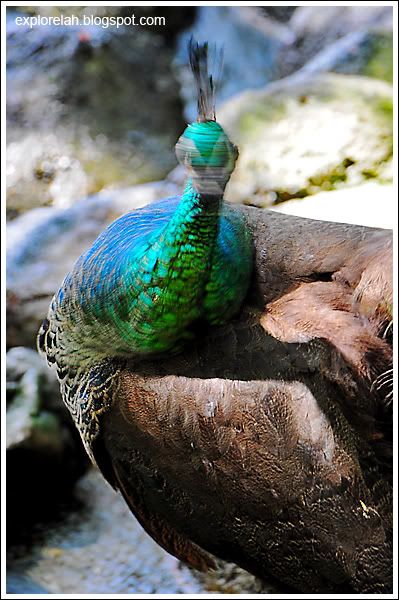 |
| Possessed by an alien? |
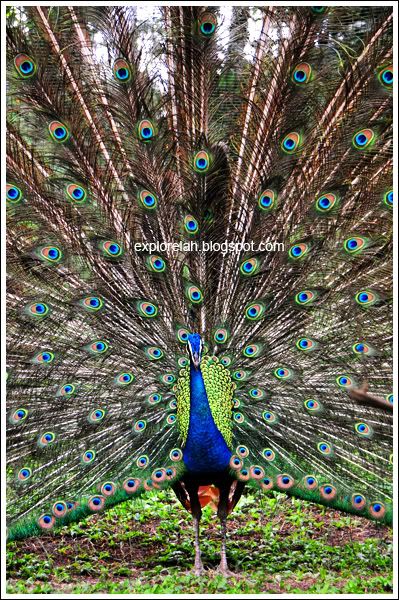 |
| First time seeing a Peacock work its advertisement for a mate in very close proximity. One word... AWESOME! |
 |
| If you've got it, flaunt it! The Peacock display is made even more electric when it jiggles the tail feathers. |
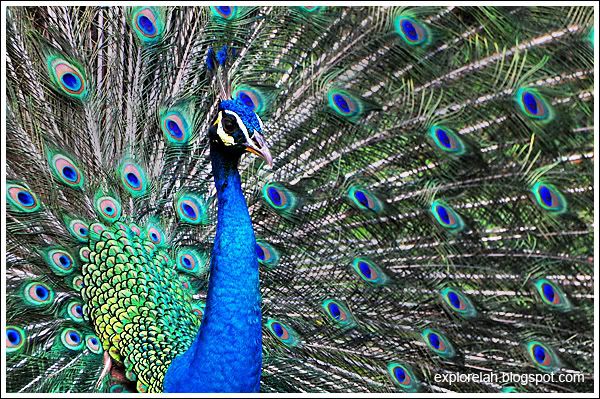 |
| A creature of such immense beauty, the Peacock seems to embody the wonders of the world. Isn't it wonderful and wondrous that something like it exits? |
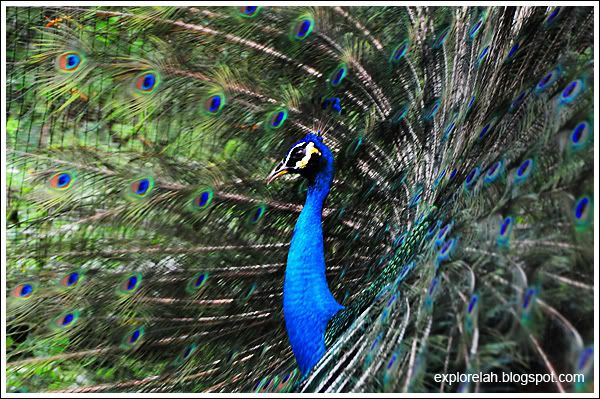 |
| My favourite Peacock shot. Taken while the Peacock was turning, causing the feathers to have a swooping effect. The bird is slightly off-focus though. Pity I couldn't replicate this effect again for a sharper shot of the bird's body. |
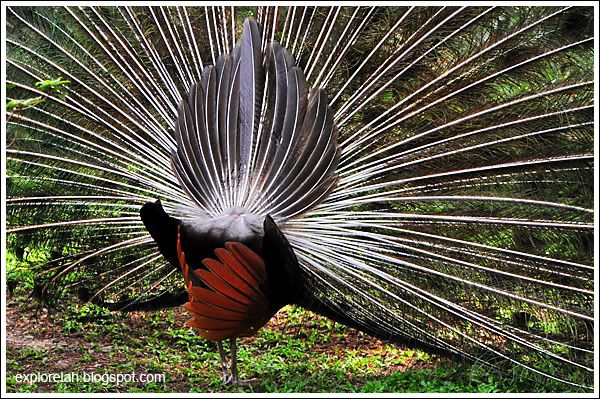 |
| The back of the Peacock is equally pretty to look at. Here's an ass I don't mind having in my face! |
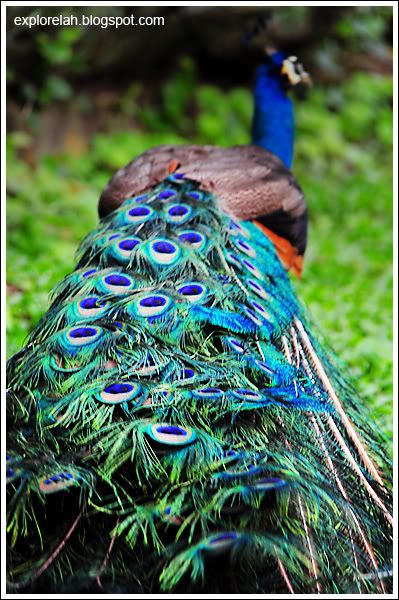 |
| Show's over! |
With the closing of the tail feathers, I'm also coming to the end of my post. I saved the Peacocks for last because they are my favourite and there's so many angles to shoot them at.
So the next time you're in Kuala Lumpur, don't miss out on looking up at birds other than the buildings. My only grouse with this place is that they have a strict no outside drinks policy. You'll have to deposit all undrank water at the entrance. A bottle of mineral water costs RM4.00 in the park. What an unfriendly way to earn a few bucks.
Address : 920, Jalan Cenderawasih, Taman Tasik Perdana, 50480 Kuala Lumpuur, Malaysia
Tel : 603-2272-1010
Opening Hours : 9.00am - 6.00pm (Daily)
Admission : RM48.00 (Adult), RM38.00 (Child)



































Extraordinary Photography Skills! You captured the essence and dynamics all within the photos of the birds. keep it going Darren! Cheers from WardrobeTrendsFashion.com(WTF) - Singapore Fashion & Lifestyle Magazine!
ReplyDeleteI visited The National Mosque of Malaysia, Petronas Towers, Kuala Lumpur Bird Park, Kuala Lumpur Tower and Jamek Mosque last year during my one week Malaysian tour. These are marvelous attractions to visit in KL. The time that I spend in Kuala Lumpur Bird Park was amazing because it is the place where you can feel the nature and observe a wide number of different species of birds. I think it is a heaven for bird lovers. Now this blog post reminded me; my Malaysian tour and I wish to go there again after my philadelphia to pittsburgh bus tour.
ReplyDelete